Tomato Sauce
Serves: 2-4
Time to make: 20 minutes – 1 hour
- 1 tbsp. olive oil
- 1 clove garlic, minced
- ½ medium onion, minced (optional)
- 1 14-ounce can diced or crushed tomatoes
- 1 tbsp. tomato paste (optional)
- ¼ cup red wine (optional)
- Salt, pepper, other seasonings to taste
Heat the oil over medium-low. Saute the garlic and and onion until golden. You can add other aromatics at this point, like mushrooms, carrots, celery, peppers or chiles, if you like.
Add the tomatoes. I strongly recommend organic canned tomatoes — they taste tons better because there is less salt and other additives, and the tomatoes they started from were better to begin with. One product I’ve grown really fond of lately is crushed organic tomatoes in a tall glass jar (I don’t remember the brand). It doesn’t have the canned taste, and you can use as much as you need and refrigerate the rest — handy!
If you want a thicker sauce, stir in tomato paste. What do you do with that leftover tomato paste? Spoon it out on wax paper by the tablespoon and freeze. Once it’s frozen, store it in freezer bags, and you’ll have pre-measured tomato paste whenever you need it. I’m also seeing tomato paste in a glass jar now, which lets you store leftovers in the refrigerator.
If you’re feeling a little ooh-la-la, add the wine and drink the rest of the bottle with dinner — otherwise, skip it. Season — an Italian dried herb mix comes in handy right about now.
Raise the heat to medium and simmer until it starts to look “saucy,” about 10 minutes (long enough to cook the pasta) or up to 45 minutes, if you so choose. Taste the sauce frequently while it’s cooking. If it tastes too acidic, stir in a little sugar. Leave it chunky or puree if you want and serve over pasta.
Of course, tomato sauce has a lot more uses than just for pasta. Now that you’ve got the basic formula down, you can whip up some tomato sauce whenever you might need it, such as when you’re making lasagne or meatball sandwiches.
Update: If you have a lot of fresh tomatoes on hand, you can also make this sauce with fresh tomatoes for immediate eating or freezing, in order to preserve your tomatoes after the growing season. About 16 roma tomatoes will make about 1 cup of sauce. The tomatoes should be peeled and chopped before cooking. I usually eliminate the onion, tomato paste and wine, especially if I’m freezing the sauce, as I can add more flavors during reheating — but the garlic is essential. Fresh tomatoes usually require only 10 minutes of cooking to break down into a thick sauce.
******************************
Ingredients
Yield: 7 pints
- Tomatoes - about 20 lbs (yes, you need a big basketful - you remove the skins, seeds and a lot of the water, so it takes a lot to start.)
- Spaghetti sauce mix or your own seasonings. The Mrs. Wages, Ball or Harvest spaghetti sauce mix sells for about $2.00 to $4.00 per packet. A packet will make about a 7 pint jars. See step 7 below for making your own seasonings.
Equipment
- 1 Water bath Canner (a huge pot to sanitize the jars after filling (about $30 to $35 - $30 at mall kitchen stores and local "big box" stores. Note: we sell many sizes and types of canners for all types of stoves and needs ). Tomatoes are on the border between the high-acid fruits that can be preserved in a boiling-water bath and the low-acid fruits, vegetables and meats that need pressure canning
- Pint canning jars (Ball or Kerr jars can be found at Publix, Kroger, Safeway and local "big box" stores - about $8 per dozen jars including the lids and rings). Pint size works best, but quarts are allowed, too, since the pressure canner will thoroughly heat them.!
- Lids - thin, flat, round metal lids with a gum binder that seals them against the top of the jar. They may only be used once.
- Rings - metal bands that secure the lids to the jars. They may be reused many times.
- Jar grabber (to pick up the hot jars)
- Lid lifter (has a magnet to pick the lids out of the boiling water where you sanitize them. ($2 at mall kitchen stores and local "big box" stores, but it's usually cheaper online from our affiliates)
- 1 large pot.
- Large spoons and ladles
- Jar funnel ($3-Grocery stores, like Publix, Kroger and Safeway and local "big box" stores; sometimes even hardware stores)
Process - How to Make Spaghetti Sauce from Fresh Tomatoes
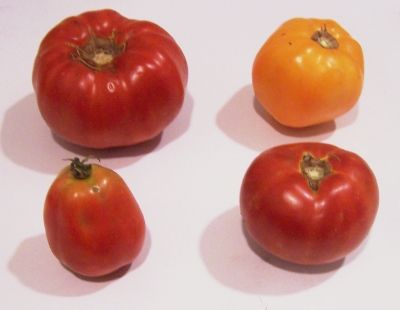 Step 1 - Selecting the tomatoes
Step 1 - Selecting the tomatoes
It's fun to go pick your own and you can obviously get better quality tomatoes!
At right is a picture of tomatoes from my garden - they are so much better than anything from the grocery store. And if you don't have enough, a pick-you-own farm is the pace to go! At right are 4 common varieties that will work:
| Top left: Beefsteak | Top right: Lemon Boy, yellow |
| Bottom left: Roma, paste-type |
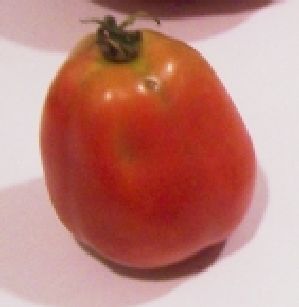 The picture at right shows the best variety of tomato to use: Roma; also called paste tomatoes. They have fewer sides, thicker, meatier walls, and less water. And that means thicker sauce in less cooking time!
The picture at right shows the best variety of tomato to use: Roma; also called paste tomatoes. They have fewer sides, thicker, meatier walls, and less water. And that means thicker sauce in less cooking time!
Also, you don't want mushy, bruised or rotten tomatoes!
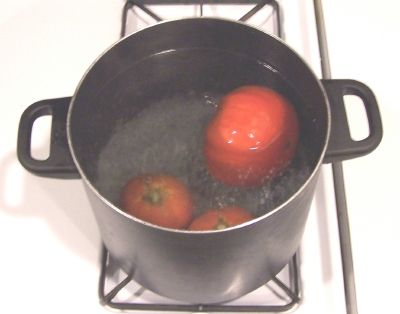 Step 2 - Removing the tomato skins
Step 2 - Removing the tomato skins
Here's a trick you may not know: put the tomatoes, a few at a time in a large pot of boiling water for no more than 1 minute (30 - 45 seconds is usually enough)
then....
Plunge them into a waiting bowl of ice water.
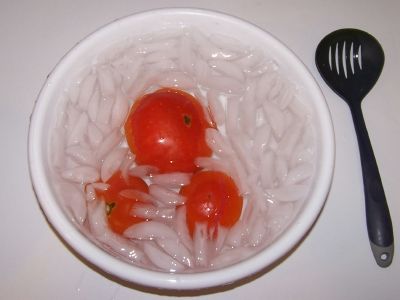 This makes the skins slide right off of the tomatoes! If you leave the skins in, they become tough and chewy in the sauce, not very pleasant.
This makes the skins slide right off of the tomatoes! If you leave the skins in, they become tough and chewy in the sauce, not very pleasant.
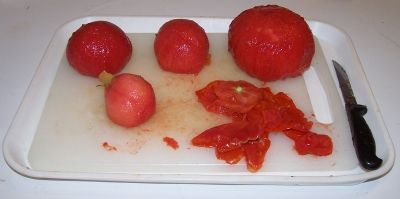 Step 3 - Removing seeds and water
Step 3 - Removing seeds and water
After you have peeled the skins off the tomatoes, cut the tomatoes in half. Now we need to remove the seeds and excess water.
 Step 4 - Squeeze of the seeds and water
Step 4 - Squeeze of the seeds and water
Just like it sounds: wash your hands then squeeze each tomato and use your finger or a  spoon to scoop and shake out most of the seeds. You don't need to get fanatical about it; removing just most will do. Another way to do it is to cut each tomato in half, across it, instead of lengthwise. Then just shake the seeds and juice out.
spoon to scoop and shake out most of the seeds. You don't need to get fanatical about it; removing just most will do. Another way to do it is to cut each tomato in half, across it, instead of lengthwise. Then just shake the seeds and juice out.
Step 5 - Drain the tomatoes
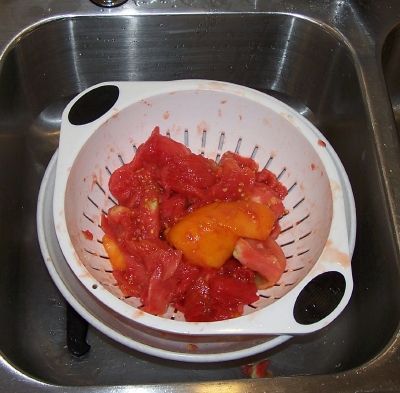 Toss the squeezed (Squozen? :) tomatoes into a colander or drainer, while you work on others. This helps more of the water to drain off. You may want to save the liquid: if you then pass it through a sieve, screen or cheesecloth, you have fresh tomato juice; great to drink cold or use in cooking! By draining the water off now, you'll end up with a thicker spaghetti sauce in less cooking time! And that preserves vitamins (and your sanity).
Toss the squeezed (Squozen? :) tomatoes into a colander or drainer, while you work on others. This helps more of the water to drain off. You may want to save the liquid: if you then pass it through a sieve, screen or cheesecloth, you have fresh tomato juice; great to drink cold or use in cooking! By draining the water off now, you'll end up with a thicker spaghetti sauce in less cooking time! And that preserves vitamins (and your sanity).
FYI, the 20 pounds of raw, fresh, whole tomatoes you started with should produce about 7 - 9 pints of "squeezed" tomatoes
Step 6 - Get the jars and lids sanitizing
 The dishwasher is fine for the jars; especially if it has a "sanitize" cycle. I get that going while I'm preparing everything else, so it's done by the time I'm ready to fill the jars.
The dishwasher is fine for the jars; especially if it has a "sanitize" cycle. I get that going while I'm preparing everything else, so it's done by the time I'm ready to fill the jars.
Be sure to let it go through the rinse cycle to get rid of any soap!
Lids: Put the lids into a pan of boiling water for at least several minutes.
Note: everything gets sanitized in the water bath (step 7)
anyway, so this just helps to ensure there is no spoilage later!)
Step 7. Mix or your own seasoning?
Either works equally well. The spaghetti sauce mix (see the Amazon.com box below) for canning has the advantage of being tested and VERY easy to use. It's basically a type of corn starch, onion powder, salt and seasoning. It doesn't have any preservative to improve the canning, so the advantage is just that it is easier and safe. Remember, this recipe is for NO meat!
Otherwise, this slightly modified version of the Ball Blue Book recipes works well:
| 2 cups chopped fresh onions (then sauté or microwave them until they are soft) | 3 Tablespoons of oregano | |
| 3 clove of garlic, minced | 2 bay leaves | |
| 2 Tablespoons diced, fresh OR dried basil | 1/4 teaspoon black pepper | |
| 2 tablespoons chopped celery (optional, may be too strong for some folk's tastes) | 2 Tablespoons chopped red sweet peppers | |
| 2 teaspoon salt (optional - I don't put any in!) | 1/4 cup lemon juice (helps to acidify it, not necessary if you have a pressure canner) | |
| 1/4 cup red wine (optional) I think a little burgundy makes it!) | ||
| And if you like your spaghetti sauce thick, add either tomato paste - 1 or 2 small cans should do it, | ||
A note about spices: Less spice, especially garlic and onions in canned sauce is better. They tend to strengthen and sometimes become bitter in storage. So use less when you prepare the sauce and add more when you actually use it, if you want!
Step 8 - Combine and bring the sauce to a gentle simmer
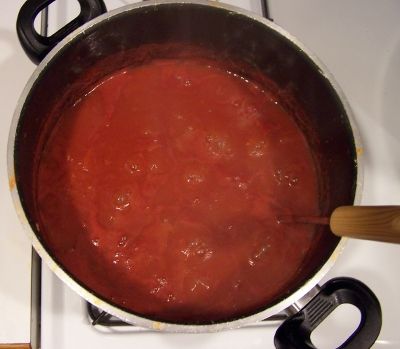 Combine the tomatoes and spices together in a big pot. There's generally no need to add liquid, most types of tomatoes have so much water, we will need to boil it down to drive off much of the water to thicken the sauce. If your tomatoes are watery, boil it down before you add the spices, to avoid them becoming too strong.
Combine the tomatoes and spices together in a big pot. There's generally no need to add liquid, most types of tomatoes have so much water, we will need to boil it down to drive off much of the water to thicken the sauce. If your tomatoes are watery, boil it down before you add the spices, to avoid them becoming too strong.
You don't need to overcook it; just bring it to boiling to sanitize it, mix the seasonings and cook down the tomatoes.
As they cook, the tomatoes will fall apart into sauce with out much need of mushing!
Step 9 - Fill the jars with sauce and put the lid and rings on
 Fill them to within ¼-inch of the top, seat the lid and hand-tighten the ring around them.
Fill them to within ¼-inch of the top, seat the lid and hand-tighten the ring around them.
NOTE: if you want to freeze the sauce instead, just fill your freezer containers (I like Ziploc freezer bags in the quart size), fill them completely, eliminate air pockets, seal them and pop them in the freezer. You're done!
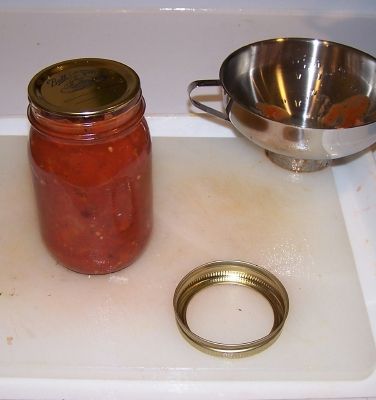 Be sure the contact surfaces (top of the jar and underside of the ring) are clean to get a good seal!
Be sure the contact surfaces (top of the jar and underside of the ring) are clean to get a good seal!
Step 10 - Process (Boil) the jars in the canner
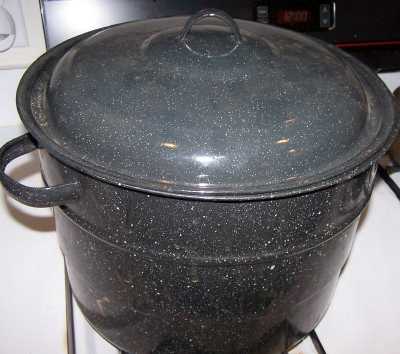
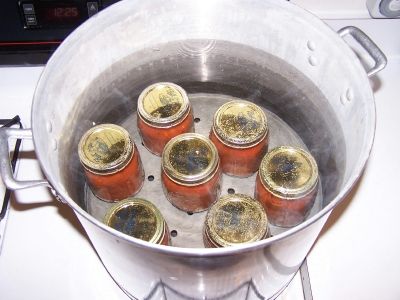 Put them in the canner and keep them covered with at least 1 inch of water. Keep the water boiling. Process the jars in a boiling-water bath for 35 minutes for pints and 40 minutes for quarts. This processing time is based on the Ball Blue Book's "Seasoned Tomato Sauce" recipe which is very similar (our recipe is actually more conservative, using less non-acidic ingredients).
Put them in the canner and keep them covered with at least 1 inch of water. Keep the water boiling. Process the jars in a boiling-water bath for 35 minutes for pints and 40 minutes for quarts. This processing time is based on the Ball Blue Book's "Seasoned Tomato Sauce" recipe which is very similar (our recipe is actually more conservative, using less non-acidic ingredients).
Of course, if you use a packet of spaghetti sauce canning mix, follow the processing times in their directions.
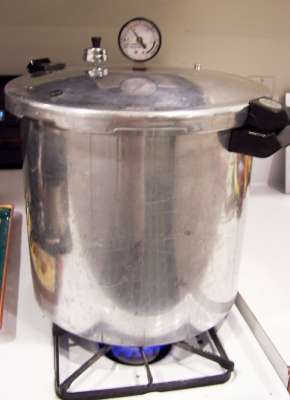 If you have a pressure canner, use it and process the sauce for the time in the tables below, as appropriate for your altitude, jar size and type of canner. Note that these times are from the USDA's recipe which is slightly different, but since the Ball recipe is safe in a water bath canner, this should work in a pressure canner.
If you have a pressure canner, use it and process the sauce for the time in the tables below, as appropriate for your altitude, jar size and type of canner. Note that these times are from the USDA's recipe which is slightly different, but since the Ball recipe is safe in a water bath canner, this should work in a pressure canner.
| Table 1. Recommended process time for Spaghetti Sauce Without Meat in a dial-gauge pressure canner. | ||||||
| Canner Gauge Pressure (PSI) at Altitudes of | ||||||
| Style of Pack | Jar Size | Process Time | 0 - 2,000 ft | 2,001 - 4,000 ft | 4,001 - 6,000 ft | 6,001 - 8,000 ft |
| Hot | Pints | 20 min | 11 lb | 12 lb | 13 lb | 14 lb |
| Quarts | 25 | 11 | 12 | 13 | 14 | |
| Table 2. Recommended process time for Spaghetti Sauce Without Meat in a weighted-gauge pressure canner. | ||||
| Canner Gauge Pressure (PSI) at Altitudes of | ||||
| Style of Pack | Jar Size | Process Time | 0 - 1,000 ft | Above 1,000 ft |
| Hot | Pints | 20 min | 10 lb | 15 lb |
| Quarts | 25 | 10 | 15 | |
This document was adapted from the "Complete Guide to Home Canning," Agriculture Information Bulletin No. 539, USDA, revised 1994.
Reviewed June 2006.
Pressure canners work better for tomatoes and other low acid foods - you'll get less spoilage with a pressure canner.
I prefer a pressure canner (see photo below) or a larger 33 quarter water bath canner, it is much deeper, so it is neater, no boilovers, and allows you to cover the tallest jars with several inches of water to ensure safety! To order one, click on Canning supplies and select the canner that is right for your stove (regular or flat bottomed for glass or ceramic stoves)
Step 11 - Done
Lift the jars out of the water and let them cool without touching or bumping them in a draft-free place (usually takes overnight) You can then remove the rings if you like. Once the jars are cool, you can check that they are sealed verifying that the lid has been sucked down. Just press in the center, gently, with your finger. If it pops up and down (often making a popping sound), it is not sealed. If you put the jar in the refrigerator right away, you can still use it. Some people replace the lid and reprocess the jar, then that's a bit iffy. If you heat the contents back up, re-jar them (with a new lid) and the full time in the canner, it's usually ok.
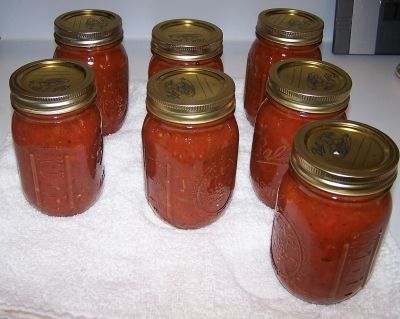
Không có nhận xét nào:
Đăng nhận xét